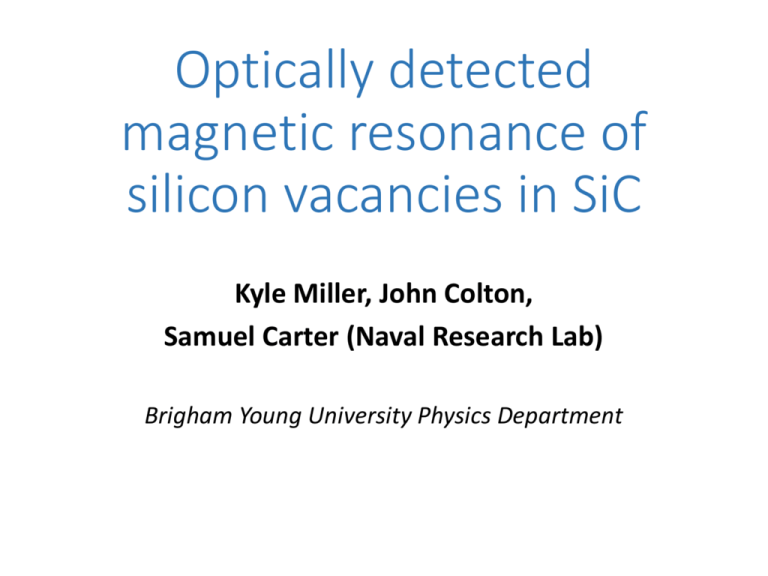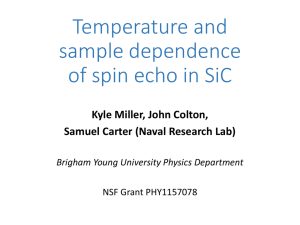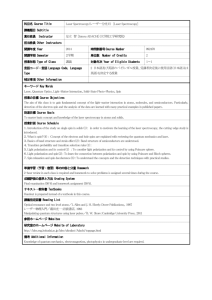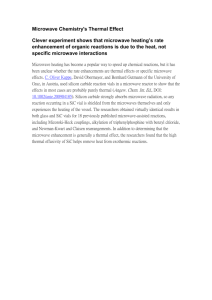Optically Detected Magnetic Resonance of silicon vacancies in SiC
advertisement

Optically detected magnetic resonance of silicon vacancies in SiC Kyle Miller, John Colton, Samuel Carter (Naval Research Lab) Brigham Young University Physics Department Background: Defects in SiC • The goal is to use silicon carbide defects for quantum information purposes (qubits) • SiC is cheaper than diamond and can be grown on a lattice • Defects occur where a silicon atom is missing • Determine spin coherence time of electrons in defects From Riedel et al., Phys. Rev. Lett. 109, 226402 (2012) Background: Electron spins and ODMR 4E ms=-1/2 ms=-3/2 B Metastable doublet ms=+3/2 ms=+1/2 2D From Sam Carter 3/2 1/2 optical Energy S=3/2 system H g B B S DS z2 4A 3/2 1/2 See P. G. Baranov et al., Phys. Rev. B 83, 125203 (2011) • Laser promotes electrons to higher energies • Non-radiative transition causes the ms=1/2 state to populate faster • Microwaves equalize spin populations, causing a decrease in the observed photoluminescence (PL) Experimental Setup • Place sample in cryostat, temperature as low as 6 K • Electromagnet provides localized field of up to 1.36 T • Microwave source combined with amplifier outputs more than 25 W • 0.7 W of 870 nm laser hitting the sample SiC B0 Cryostat µwave source Electromagnet Maximizing microwave power • Coupling loop is made from the inner conductor of the coax • Sample placed directly on the copper cold finger SiC B0 Maximizing microwave power • Stub tuners, or “slide trombones”, help tune standing wave patterns • They match the impedance of the loop for maximum radiation output Double stub Single stub ODMR • Two resonant peaks, one varies in strength • Linear field dependence ℎ𝑓 = 𝑔𝜇𝐵 𝐵 𝑓 𝑔𝜇𝐵 = 𝐵 ℎ 𝑔 ≈ 1.996 • Very close to 2 ODMR – Microwave power • Increased response with increased microwave power • Width also increases Rabi oscillations 5 µs 1 µs Laser Vary length (0 – 1000 ns) Laser • These occur when electrons are switched continuously up and down between spin states (See video) • Stronger microwave power means faster oscillations • This gives 𝜋 and 𝜋 2 pulses (which flip spins upside down and half-way upside down) 250 MHz 207 MHz Spin echo 20 µs 2 µs Laser 𝑻𝒇𝒊𝒙𝒆𝒅 𝜋 2 𝜋 𝜋 2 Laser 𝒕𝒓𝒂𝒎𝒔𝒆𝒚 • Set 𝑇𝑓𝑖𝑥𝑒𝑑 , then vary 𝑡𝑟𝑎𝑚𝑠𝑒𝑦 to observe the signal • Microwave pulses manipulate spin orientation • Signal is seen when pulses are equally spaced See video "HahnEcho GWM" by GavinMorley - Gavin W Morley. Licensed under Creative Commons Attribution-Share Alike 3.0 via Wikimedia Commons http://commons.wikimedia.org/wiki/File:HahnEcho_GWM.gif#mediavie wer/File:HahnEcho_GWM.gif Spin echo data • Exponential decay of the signal predicts 𝑇2 • Important figure is the percentage of the way toward 0 Calculating T2 • Fitting the exponential decay of the spin echo signal gives T2 Echo signal, 40 K Summary • Spin coherence time ≈ 16μs • Is this long? • Pretty good. Long for GaAs, not super long for diamond • Can we get longer? • Apparently not with temp, maybe with defect concentration • What is the limiting factor on the lifetime? Future work • Try different samples with varying amounts of defects from irradiation • NSF Grant PHY1157078






